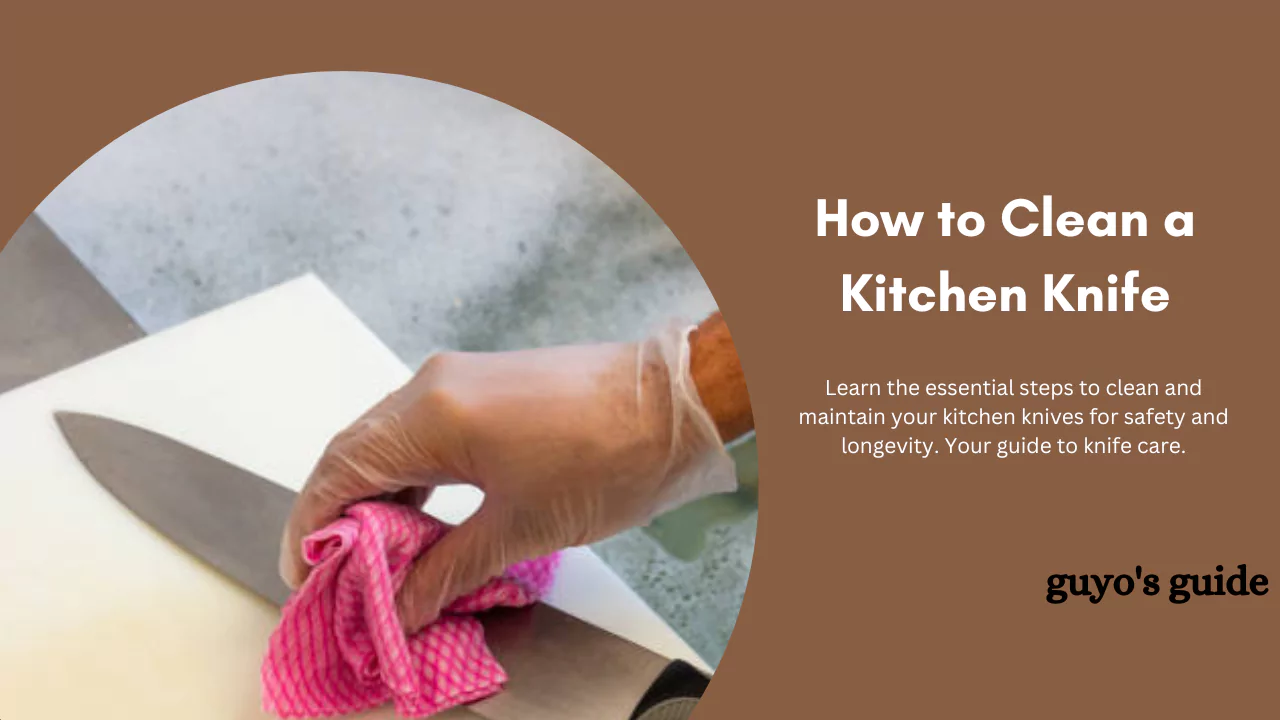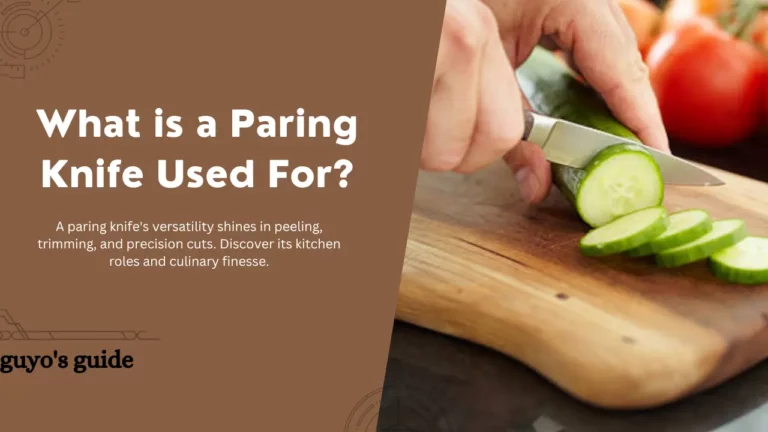How to Clean a Kitchen Knife (+ Rusty Knife)


A clean kitchen knife is not only essential for maintaining food hygiene but also crucial for ensuring safe and efficient cooking.
In this article, we will guide you through the step-by-step process of how to clean a kitchen knife effectively and a bonus of how to clean a rusty one.
By following these simple instructions, you can keep your knife spotless and ready for use, while minimizing the risk of cross-contamination.
Let’s dive in.
Steps on How to Clean a Kitchen Knife
Cleaning a kitchen knife is an essential task to ensure it remains safe and in good working condition. Proper knife maintenance can also prolong the life of your knives. Here is a definitive guide on how to clean a kitchen knife:
Materials you’ll need:
- Dishwashing liquid or mild soap
- Warm water
- A soft sponge or dishcloth
- Towel or dish rack for drying
- Cutting board
Step 1: Safety First
Before you start cleaning your kitchen knife, be sure to take some safety precautions:
- Make sure the knife’s blade is pointing away from you at all times.
- Handle the knife by the handle or grip area, not the blade.
- Keep your fingers away from the sharp edge of the blade.
Step 2: Rinse the Knife
Hold the knife under warm, running water to remove any loose debris, food particles, or residues.
Rinse both sides of the blade, the handle, and the bolster (the thick part where the blade meets the handle).
Step 3: Prepare a Soapy Solution
Fill a sink or a basin with warm water and add a few drops of dishwashing liquid or mild soap. Make sure the water is not too hot, as extreme temperature changes can damage the blade.
Step 4: Soak the Knife
Submerge the knife in the soapy water. This will help to loosen any stubborn food residues and make the cleaning process easier.
Let it soak for a few minutes, but do not leave it for an extended period, as prolonged exposure to water can damage the knife.
Step 5: Clean the Blade
Using a soft sponge or dishcloth, gently scrub the blade on both sides to remove any remaining food particles and stains.
Be sure to wipe in the direction of the blade, not against it, to avoid accidentally cutting yourself.
Pay extra attention to the area near the handle, as this is a common spot for food residue buildup.
Step 6: Clean the Handle
Clean the handle and any other parts of the knife that may have come into contact with food or grease. Make sure to remove any sticky or oily residues.
Step 7: Rinse Thoroughly
Rinse the knife under warm running water to remove all soap and food residue, making sure no soap is left on the blade or handle.
Step 8: Dry the Knife
Use a clean towel to dry the knife thoroughly. Make sure the knife is completely dry to prevent any moisture-related issues like rust.
Step 9: Store the Knife Properly
Store your clean, dry knife in a knife block, magnetic strip, knife sheath, or on a knife rack.
Do not toss it into a drawer with other utensils, as it can become damaged and dull from contact with other objects.
Additional Tips:
- Avoid using abrasive scouring pads or steel wool, as they can scratch and damage the knife’s surface.
- Do not leave your knife in the sink or submerged in water for extended periods.
- Clean your knife immediately after use to prevent food from drying and adhering to the blade.
- If your knife has a wooden handle, be extra cautious not to soak the handle in water, as excessive moisture can cause it to swell and crack.
Steps on How to Clean a Rusty Kitchen Knife
Cleaning a rusty kitchen knife is essential to restore its functionality and prevent further corrosion. Rust on a knife’s blade can compromise its performance and safety. Here’s a definitive guide on how to clean a rusty kitchen knife:
Materials you’ll need:
- Rusty knife
- Distilled white vinegar or lemon juice
- Baking soda
- Soft sponge or cloth
- A non-abrasive scrubbing pad
- Towel or paper towels
- Food-grade mineral oil or cooking oil
- Steel wool (fine or extra fine)
Step 1: Safety First
Before you begin, ensure your own safety. Handle the knife carefully to avoid accidents, as rust can create sharp and uneven surfaces.
Step 2: Assess the Rust
Examine the knife to determine the extent of rust. If the rust is minor and only surface-deep, you can likely remove it with this process.
However, if the rust is extensive, it might be best to seek professional help or consider replacing the knife.
Step 3: Soak the Knife
Fill a container with distilled white vinegar or lemon juice. Submerge the rusty part of the knife in the liquid and let it soak for at least 30 minutes. These acidic solutions will help dissolve the rust.
Step 4: Scrub with Baking Soda
After soaking, remove the knife from the vinegar or lemon juice and sprinkle baking soda directly onto the rusty areas. Use a soft sponge or cloth to gently scrub the rusted spots.
The baking soda will act as a mild abrasive to help remove the rust without damaging the blade.
Step 5: Use a Non-abrasive Scrubbing Pad
For more stubborn rust, you can use a non-abrasive scrubbing pad in addition to the baking soda.
Continue to scrub the rusted areas, maintaining a gentle pressure. Avoid using steel wool at this stage, as it may scratch the knife’s surface.
Step 6: Rinse and Dry
Rinse the knife thoroughly with water to remove the vinegar, lemon juice, baking soda, and rust particles. Pat the knife dry with a towel or paper towel.
Step 7: Steel Wool for Stubborn Rust (Optional)
If some rust persists, you can use fine or extra fine steel wool to gently scrub the rusted areas.
Be careful not to apply too much pressure and avoid the knife’s edge. This step should be used sparingly to avoid removing excessive metal.
Step 8: Apply Oil
To prevent future rust, apply a small amount of food-grade mineral oil or cooking oil to the blade.
This will create a protective barrier against moisture. Wipe the knife with a cloth to ensure even coverage.
Step 9: Store Properly
Store the knife in a dry, well-ventilated area and avoid storing it in a damp environment or with other utensils that may promote rust.
Tips on How to Maintain a Clean Kitchen Knife
Maintaining a clean kitchen knife is essential for its longevity and safe use. Here are some tips on how to keep your kitchen knife clean and in good condition:
1. Clean Immediately after Use
After using your knife, rinse it under warm water and wipe it clean with a dishcloth or sponge. This helps prevent food residues from drying and adhering to the blade.
2. Use a Mild Detergent
Wash your knife with a mild dishwashing liquid or soap. Avoid using harsh or abrasive cleaners, as they can damage the blade or handle.
3. Hand Wash Only
Never put your knives in the dishwasher. The high heat and abrasive detergents can cause the knife to become dull and corroded. Hand washing is the safest way to clean your knife.
4. Dry Thoroughly
After washing, use a clean towel to dry your knife immediately. Make sure it’s completely dry to prevent moisture-related issues like rust.
5. Store Properly
Store your knives in a knife block, magnetic strip, knife sheath, or on a knife rack. Avoid storing them loosely in a drawer with other utensils, as they can become damaged or dulled from contact.
6. Use a Cutting Board
Always use a soft, wooden, or plastic cutting board to protect the knife’s edge. Avoid cutting on hard surfaces like glass, granite, or ceramic, as they can damage the blade.
7. Regular Sharpening
Sharpen your knife regularly to maintain its sharpness. You can use a honing steel or sharpening stone. If you’re not confident in your sharpening skills, consider having your knives professionally sharpened.
8. Use a Knife Guard or Blade Cover
When not in use, use a knife guard or blade cover to protect the knife’s edge. This prevents accidental cuts and keeps the blade in good condition.
9. Avoid Twisting and Prying
Never use the knife for tasks it’s not designed for, such as twisting or prying. This can damage the blade and even cause it to snap.
10. Refrain from Cutting Frozen Foods
Avoid using your kitchen knife to cut frozen foods. Allow frozen items to thaw slightly, or use a dedicated frozen food knife.
11. Use a Soft Touch
When cutting, use a gentle, controlled motion. Let the sharpness of the blade do the work rather than applying excessive force, which can lead to chipping and dulling.
12. Regular Inspection
Inspect your knife regularly for any signs of damage, such as chips or bent blades. If you notice any issues, address them promptly.
13. Oil the Blade
To prevent rust, periodically apply a small amount of food-grade mineral oil to the blade. This will create a protective barrier against moisture.
FAQs
Can I clean my kitchen knife in the dishwasher?
No, it’s not recommended to clean your kitchen knife in the dishwasher. The high heat and abrasive detergents can damage the blade, handle, and even the cutting edge, leading to dullness and corrosion. Hand washing is the safest method.
What’s the best way to remove stubborn food residue from a knife blade?
Soak the knife in warm, soapy water to loosen the residue, and then use a soft sponge or cloth to gently scrub the blade. If the residue is still stubborn, you can use a non-abrasive scrubbing pad with baking soda to help remove it.
Can I use steel wool to remove rust from my knife?
Yes, you can use fine or extra fine steel wool to remove rust from a knife, but be cautious not to apply excessive pressure, which may remove too much metal. It’s best to use steel wool sparingly and as a last resort.
How often should I sharpen my kitchen knife?
The frequency of sharpening depends on how often you use your knife and the type of cutting tasks you perform. In general, knives should be sharpened regularly to maintain their sharpness. Honing with honing steel can help maintain the edge between sharpenings.
Should I oil my knife regularly, even if it’s not rusty?
It’s a good practice to periodically apply a small amount of food-grade mineral oil to the knife’s blade to create a protective barrier against moisture, even if the knife is not rusty. This helps prevent rust and keeps the blade in good condition.
Can I clean the handle of my knife in the same way as the blade?
Yes, you can clean the handle of your knife with warm, soapy water and a soft sponge or cloth. Be cautious not to soak the handle excessively, especially if it’s made of wood, as prolonged exposure to water can cause damage.
How do I clean knife stains or discoloration from acidic foods like tomatoes or lemons?
Stains or discoloration caused by acidic foods can often be removed by gently scrubbing the affected area with a mixture of baking soda and water. Rinse and dry the knife afterward.
Wrap Up
Proper knife maintenance is crucial for both the safety and the longevity of your kitchen tools.
By following the steps outlined in this article, you can ensure that your kitchen knives remain clean, sharp, and in excellent condition.
Regular cleaning, drying, and occasional sharpening are simple practices that go a long way in preserving the utility and safety of these essential culinary instruments.






